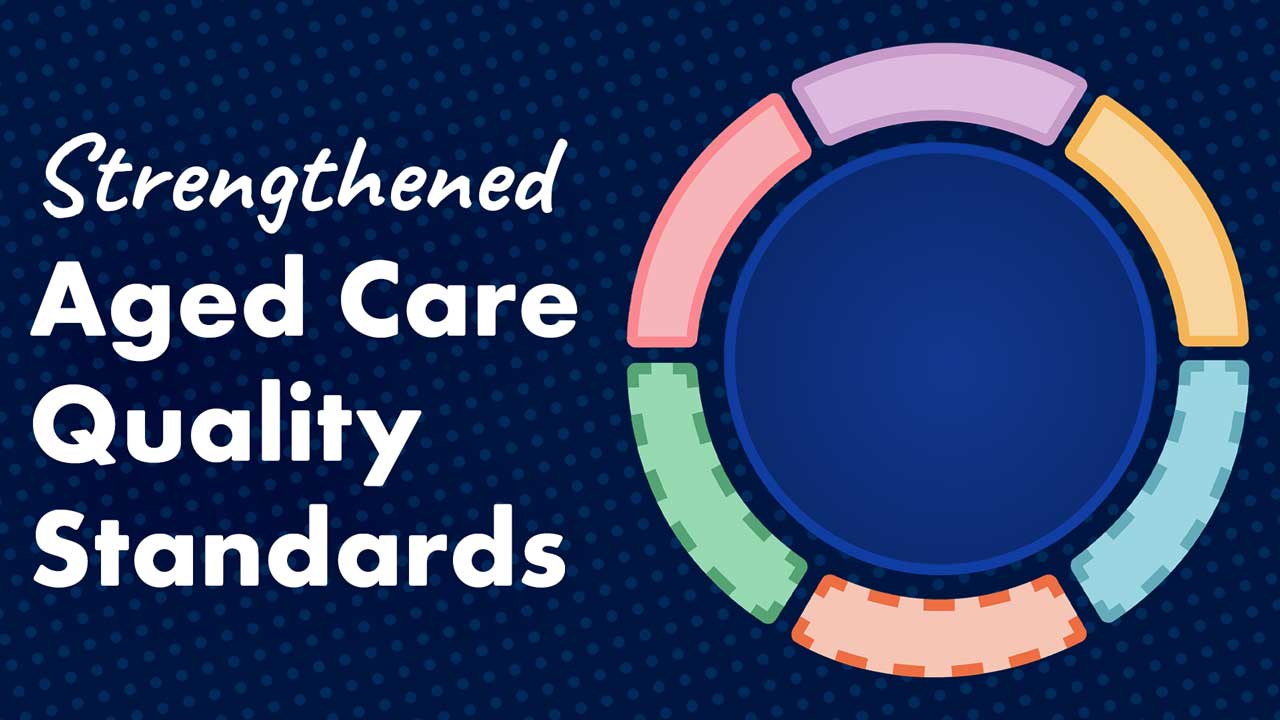The Aged Care Quality Standards are set to be updated as part of a proposed new Aged Care Act and regulatory model, as recommended by the Royal Commission into Aged Care Quality and Safety (ACQSC 2025).
This Article will provide a brief overview of each of the strengthened Standards. For more comprehensive information on each Standard, see Ausmed’s Training Modules on this topic.
What are the Seven Strengthened Aged Care Quality Standards?
- The Individual
- The Organisation
- Care and Services
- The Environment
- Clinical Care
- Food and Nutrition
- The Residential Community.
Standard 1: The Individual
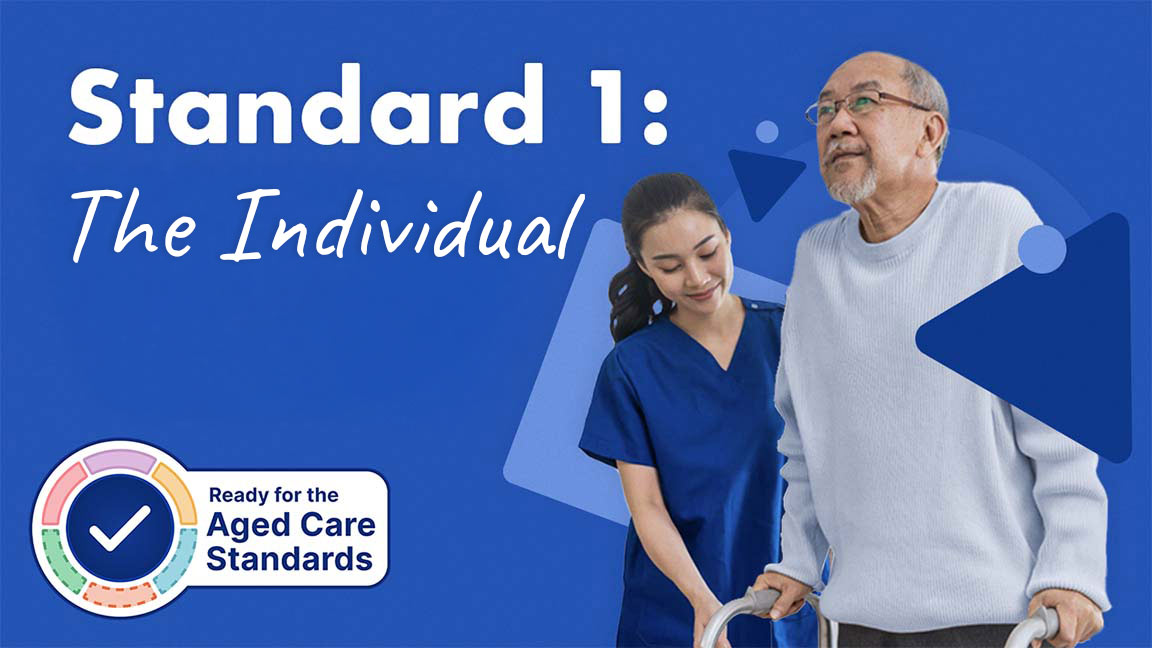
‘I have the right to be treated with dignity and respect and to live free from any form of discrimination. I make decisions about my care and services, with support when I want or need it. My identity, culture and diversity are valued and supported, and I have the right to live the life I choose. My provider understands who I am and what is important to me, and this determines the way my care and services are delivered.’
Standard 1: The Individual recognises each older person as an individual and acknowledges the importance of maintaining their sense of self as they age.
Standard 1 comprises:
- Outcome 1.1: Person-centred care
- Outcome 1.2: Dignity, respect and privacy
- Outcome 1.3: Choice, independence and quality of life
- Outcome 1.4: Transparency and agreements.
(DoHDaA 2025)
Standard 2: The Organisation
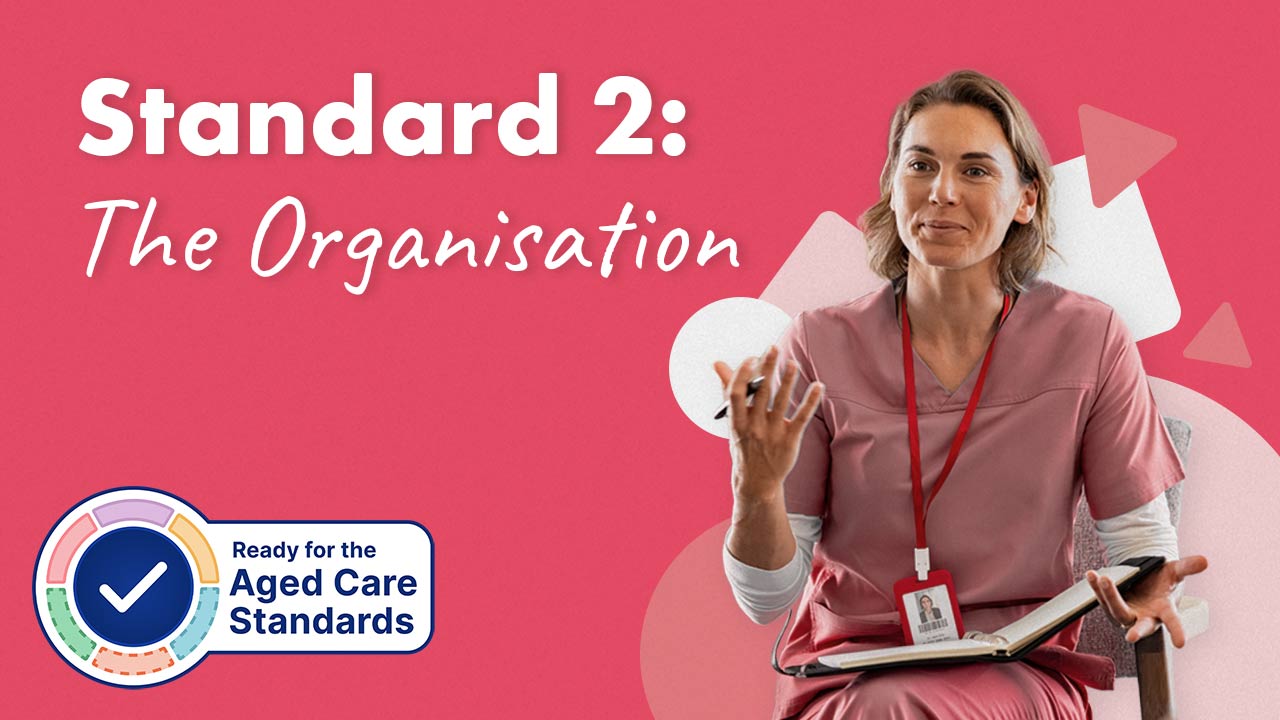
‘The organisation is well run. I can contribute to improvements to care and services. My provider and workers listen and respond to my feedback and concerns. I receive care and services from workers who are knowledgeable, competent, capable and caring.’
Standard 2: The Organisation outlines the responsibilities of a provider’s governing body to the older people in their care. Responsibilities like:
- Fostering a culture centred on safety and quality
- Overseeing and evaluating enhancements to care and services
- Engaging with older people, their families, caregivers and staff, as well as collecting quality data to ensure continuous improvement
- Establishing effective governance systems
- Ensuring the workforce is skilled and equipped to meet the needs of older people in their care
Standard 2 comprises:
- Outcome 2.1: Partnering with older people
- Outcome 2.2: Quality and safety culture
- Outcome 2.3: Accountability and quality systems
- Outcome 2.4: Risk management
- Outcome 2.5: Incident Management
- Outcome 2.6: Feedback and complaints management
- Outcome 2.7: Information management
- Outcome 2.8: Workforce planning
- Outcome 2.9: Human resource management
- Outcome 2.10: Emergency and disaster management.
(DoHDaA 2025)
Standard 3: The Care and Services
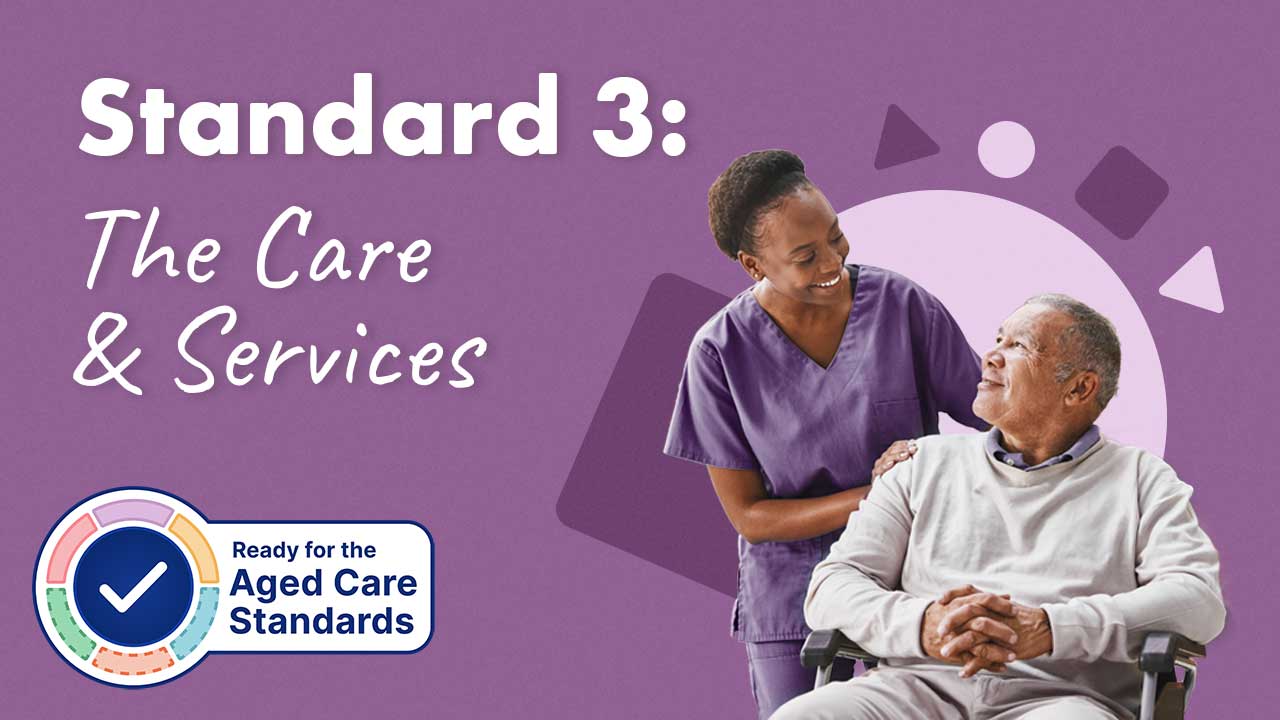
‘The care and services I receive:
- are safe and effective
- optimise my quality of life, including through maximising independence and reablement
- meet my current needs, goals and preferences
- are well-planned and coordinated
- respect my right to take risks.’
Standard 3: The Care and Services focuses on the quality, safety and appropriateness of all types of care and services that older people receive. While other Standards focus on specific service requirements, Standard 3 emphasises the importance of effective assessment, planning, communication and coordination. Such measures are crucial for delivering high-quality care and services that cater to the individual needs and preferences of older people, empowering them to lead fulfilling lives.
Standard 3 comprises:
- Outcome 3.1: Assessment and Planning
- Outcome 3.2: Delivery of Care and Services
- Outcome 3.3: Communicating for safety and quality
- Outcome 3.4: Coordination of care and services.
(DoHDaA 2025)
Standard 4: The Environment
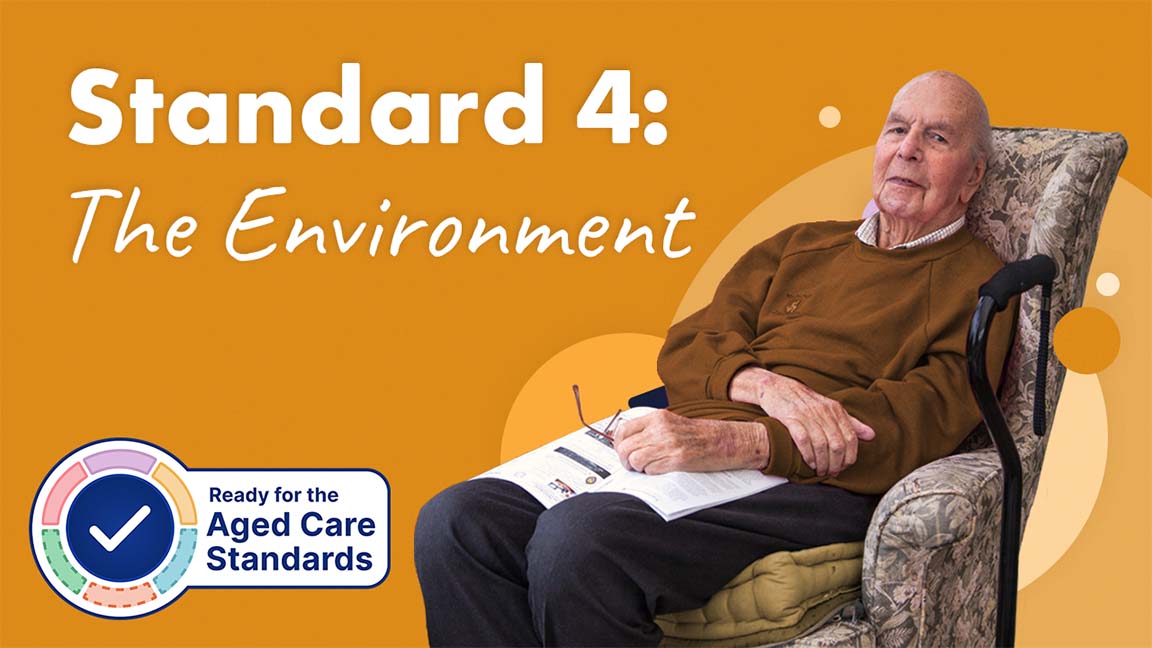
‘I feel safe when receiving care and services. Where I receive care and services through a service environment, the environment is clean, safe and comfortable and enables me to move around freely. Equipment is safe, appropriate and well-maintained and precautions are taken to prevent the spread of infections.’
Standard 4: The Environment focuses on fostering a safe and comfortable care environment for older people that encourages a sense of independence and belonging.
Standard 4 comprises:
- Outcome 4.1a: Environment and equipment at home
- Outcome 4.1b: Environment and equipment in a service environment
- Outcome 4.2: Infection prevention and control.
(DoHDaA 2025)
Standard 5: Clinical Care

‘I receive person-centred, evidence-based, safe, effective, and coordinated clinical care by qualified health professionals and competent workers that meets my changing clinical needs and is in line with my goals and preferences.’
Clinical care encompasses:
- Preventing, treating and managing health conditions
- Preserving mental, physical, and social wellbeing
- Interprofessional care.
(ACQSC 2024)
Many older people have complex health needs, such as multiple chronic conditions, disability, frailty and/or cognitive challenges. Appropriate clinical care is crucial in properly addressing these needs and maximising the quality of life for older people while managing risks associated with their care.
Standard 5 comprises:
- Outcome 5.1: Clinical Governance
- Outcome 5.2: Preventing and controlling infections in clinical care
- Outcome 5.3: Safe and quality use of medicines
- Outcome 5.4: Comprehensive care
- Outcome 5.5: Clinical Safety
- Outcome 5.6: Cognitive Impairment
- Outcome 5.7: Palliative and End-of-life care.
Note: Outcome 5.5: Clinical Safety seeks to strengthen and prioritise high-impact and high-prevalence clinical areas of risk identified by the Royal Commission into Aged Care Quality and Safety. These areas include:
- Choking and swallowing
- Continence
- Falls and mobility
- Nutrition and hydration
- Mental health
- Oral health
- Pain
- Pressure injury and wounds
- Sensory impairment.
(DoHDaA 2025)
Standard 6: Food and Nutrition

‘I receive plenty of food and drinks that I enjoy. Food and drinks are nutritious, appetising and safe, and meet my needs and preferences. The dining experience is enjoyable, includes variety and supports a sense of belonging.’
Standard 6: Food and Nutrition recognises that access to nutritionally appropriate food is a basic human right and acknowledges that mealtimes have cultural and social importance for many people. At the same time, older people’s ability to eat and drink might be affected by various health and age-related factors and must also be carefully considered and addressed.
Note: Standard 6 applies only to residential care services.
Standard 6 comprises:
- Outcome 6.1: Partnering with older people on food and nutrition
- Outcome 6.2: Assessment of nutritional needs and preferences
- Outcome 6.3: Provision of food and drink
- Outcome 6.4: Dining experience.
(DoHDaA 2025)
Standard 7: The Residential Community
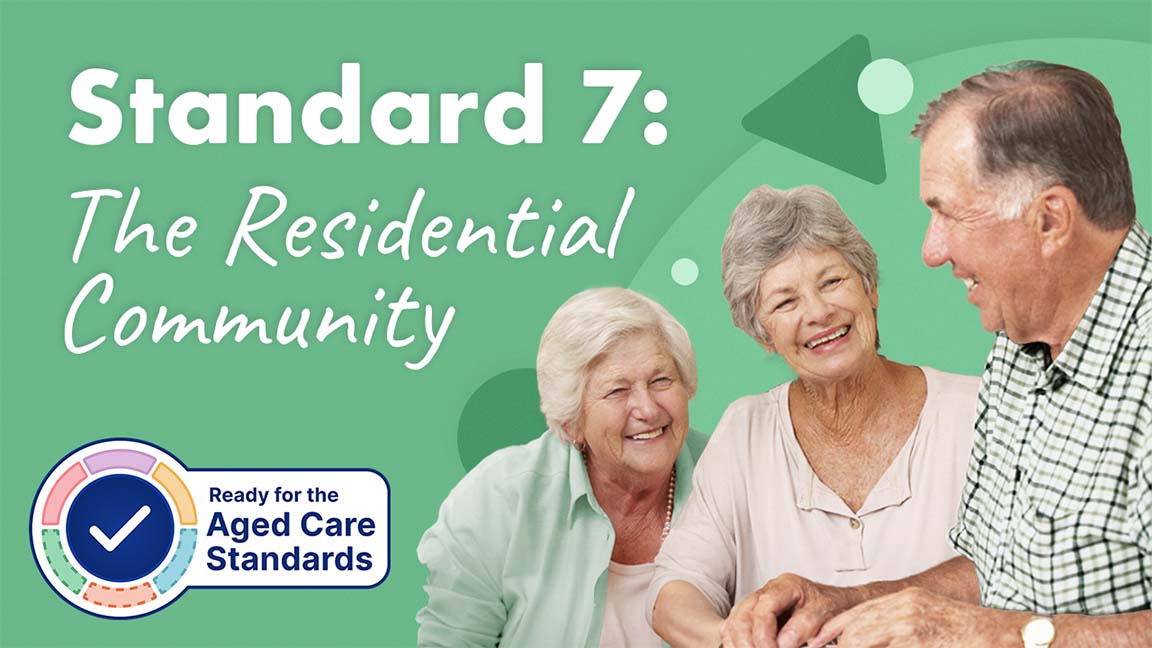
‘I am supported to do the things I want and to maintain my relationships and connections with my community. I am confident in the continuity of my care and security of my accommodation.’
Standard 7: The Residential Community focuses on the importance of the residential community in the lives of older people who have moved into a residential care environment, and emphasises the necessity for older people to feel safe, comfortable and at home. This standard also highlights the significance of providing opportunities for older people to engage in meaningful activities and maintain connections with important people in their lives.
Note: Standard 7 applies only to residential care services.
Standard 7 comprises:
- Outcome 7.1: Daily living
- Outcome 7.2: Transitions.
(DoHDaA 2025)
Topics
Further your knowledge
 Free
Free






References
- Aged Care Quality and Safety Commission 2024, Draft Glossary of Terms for the Strengthened Quality Standards, Australian Government, viewed 1 July 2025, https://www.agedcarequality.gov.au/resource-library/draft-glossary-terms-strengthened-quality-standards
- Aged Care Quality and Safety Commission 2025, Strengthened Quality Standards, Australian Government, viewed 1 July 2025, https://www.agedcarequality.gov.au/providers/quality-standards/strengthened-quality-standards
- Department of Health, Disability and Ageing 2025, Strengthened Aged Care Quality Standards, Australian Government, viewed 1 July 2025, https://www.health.gov.au/resources/publications/strengthened-aged-care-quality-standards-august-2025?language=en
 New
New 